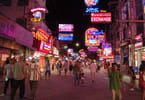A budding tropical system may pass close enough to Hawaii to bring an uptick in gusty showers and thunderstorms as well as building seas late in the week.
How significant these impacts become will depend on the track and strength of the system, which is projected to move along at a swift pace of 17 to 23 miles per hour.
While there are several areas in the Eastern and Central Pacific that bear watching this week, one system in particular southeast of Hawaii is of the greatest concern.
As of Monday morning, the strongest system is located about 1,700 miles east-southeast of the Big Island of Hawaii and is being monitored for development as the week progresses. This system is currently drifting toward Hawaii.
At present course and speed, the system could begin to produce squalls on the Big Island during Thursday. The sudden squalls could catch boaters off guard. Rip currents may increase in strength and number, especially along north- and east-facing beaches during the latter part of the week.
The fast pace of the system could prevent it from becoming very powerful.
People traveling to or living in the Hawaiian Islands will want to monitor the progress of the disturbance, which could develop into a depression, tropical storm or hurricane. The next name on the list, depending on where the system develops, is Dolores in the East Pacific or Ela in the Central Pacific.
The Eastern Pacific basin extends from North America to 140 degrees East longitude. The Central Pacific basin extends from 140 degrees to 180 degrees East longitude.
According to AccuWeather Meteorologist Eric Leister, most of the time waters are rather cool, relatively speaking around Hawaii and act as a deterrent to tropical activity.
“During El Niño years, waters around Hawaii can run above average,” Leister said. “In this case, water temperatures are running several degrees Fahrenheit higher than average.”
The warm waters could give the system a boost or cause it to develop quickly.
At this time, a path just east and north of the islands appears most likely, but that could change since the system is currently poorly organized.
According to AccuWeather Hurricane Expert Dan Kottlowski, “Because of shifting upper-level winds in the atmosphere, it is too early to say for sure whether this system would track very close to the Big Island or veer to the west or east of the islands in general.”
As El Niño began to ramp up during the latter half of 2014, Hawaii saw two developed tropical systems pass close by. One was Iselle, which made landfall on the Big Island of Hawaii as a tropical storm on Aug. 7. Another well-developed system, named Ana, impacted the islands during the middle of October.
Once a powerful Category 4 hurricane, Iselle was the strongest tropical cyclone to make landfall on the Big Island on record. Iselle cause downed trees, power outages and property damage along with flooding rain and travel disruptions.
Ana passed just to the south and west of the islands as a hurricane and produced locally heavy rain.
Other systems such as Wali, Genevieve and Julio either passed well away from the islands or had minimal effect.
Hurricanes in the Central Pacific basin are uncommon with three or four named, but relatively weak systems per year over the entire basin.
“This could be a busy year again for Hawaii, in terms of tropical systems passing nearby, as the effect of El Niño continues and perhaps reaches a peak during hurricane season,” Kottlowski said.
WHAT TO TAKE AWAY FROM THIS ARTICLE:
- According to AccuWeather Hurricane Expert Dan Kottlowski, “Because of shifting upper-level winds in the atmosphere, it is too early to say for sure whether this system would track very close to the Big Island or veer to the west or east of the islands in general.
- The next name on the list, depending on where the system develops, is Dolores in the East Pacific or Ela in the Central Pacific.
- As of Monday morning, the strongest system is located about 1,700 miles east-southeast of the Big Island of Hawaii and is being monitored for development as the week progresses.






















